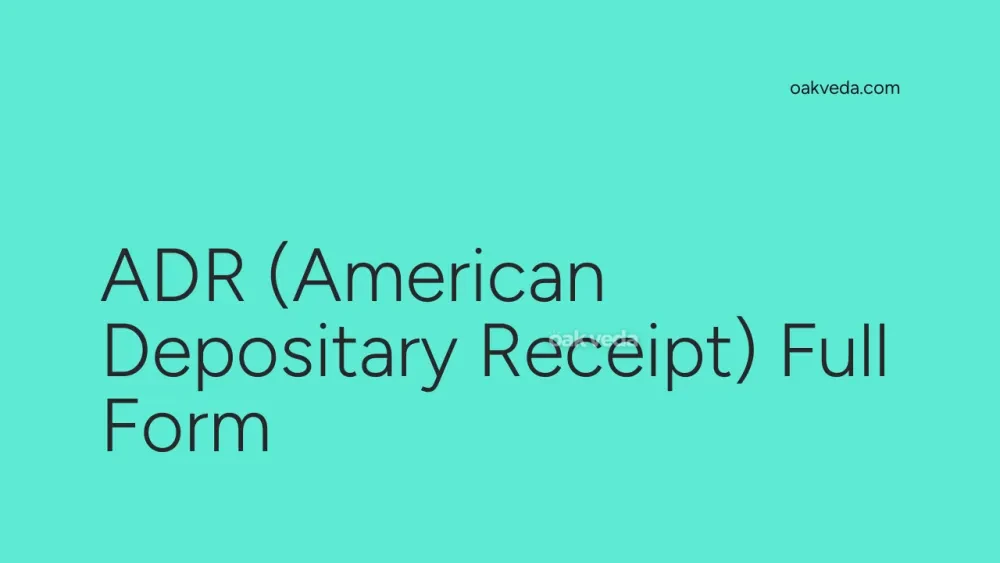
What is the Full Form of ADR?
The full form of ADR is American Depositary Receipt. This financial instrument plays a crucial role in international investing and cross-border capital markets.
What is American Depositary Receipt?
An American Depositary Receipt (ADR) is a negotiable certificate issued by a U.S. depositary bank that represents ownership in a specified number of shares of a foreign company's stock. ADRs trade on U.S. financial markets, including major exchanges like the New York Stock Exchange (NYSE) and NASDAQ, just like domestic stocks.
Origin and Development of American Depositary Receipts
ADRs were first introduced in 1927 as a way to facilitate U.S. investors' ability to invest in foreign companies. The concept was developed to overcome the challenges associated with buying shares in foreign markets, such as differences in currency, accounting practices, and regulatory environments.
How does American Depositary Receipt work?
The process of creating and trading ADRs involves several steps:
- A U.S. depositary bank purchases shares of a foreign company in the company's home market.
- The bank holds these shares as inventory and issues ADRs based on them.
- Each ADR represents a specific number of underlying shares, which can vary from a fraction of a share to multiple shares.
- The ADRs are then listed on U.S. exchanges and can be bought, sold, or traded by American investors just like domestic stocks.
- When an investor buys an ADR, they are essentially buying the foreign shares, but in a format that is familiar and convenient for U.S. investors.
Types of American Depositary Receipts
ADRs are typically categorized into three levels:
- Level I ADRs: These trade over-the-counter and have the least stringent requirements.
- Level II ADRs: These are listed on major U.S. exchanges and require the foreign company to meet more rigorous reporting standards.
- Level III ADRs: These allow the foreign company to raise capital through a public offering in the U.S. market and have the most stringent requirements.
Functions of American Depositary Receipts
ADRs serve several important functions in the global financial markets:
- Facilitate international investment for U.S. investors
- Provide foreign companies access to U.S. capital markets
- Enhance global liquidity for shares of international companies
- Bridge the gap between different financial markets and regulatory environments
Applications of American Depositary Receipts
ADRs are widely used in various financial scenarios:
- Portfolio Diversification: Investors use ADRs to gain exposure to foreign markets and diversify their portfolios.
- Capital Raising: Foreign companies use ADRs to access U.S. capital markets and expand their investor base.
- Cross-Border Mergers and Acquisitions: ADRs can facilitate international M&A transactions.
- Employee Stock Ownership Plans: Multinational companies may use ADRs in their global employee stock plans.
Features of American Depositary Receipts
Key features of ADRs include:
- Denominated in U.S. dollars
- Trade on U.S. financial markets during U.S. market hours
- Cleared through U.S. settlement systems
- Dividends paid in U.S. dollars
- Subject to U.S. securities laws and regulations
Benefits of American Depositary Receipts
ADRs offer numerous advantages to both investors and foreign companies:
For Investors:
- Easy access to foreign investments
- Reduced currency conversion costs
- Familiar trading and settlement procedures
- Improved transparency through U.S. reporting standards
For Foreign Companies:
- Access to U.S. capital markets
- Increased visibility and prestige in the U.S. market
- Expanded shareholder base
- Potential for higher valuation
Limitations or Challenges of American Depositary Receipts
Despite their benefits, ADRs also come with certain limitations:
- Currency exchange rate risks
- Potential for additional fees and taxes
- Limited selection of available companies
- Possible discrepancies between ADR and home market share prices
- Regulatory complexities for issuing companies
Future Developments in American Depositary Receipt Technology
The ADR market continues to evolve with technological advancements and changing global financial landscapes:
- Blockchain Integration: Exploring the use of blockchain technology for more efficient ADR issuance and trading.
- Expansion to Emerging Markets: Increasing focus on ADRs from emerging market companies.
- Enhanced Digital Platforms: Development of more sophisticated digital platforms for ADR trading and information dissemination.
- Regulatory Harmonization: Efforts to streamline regulations across different markets to facilitate smoother ADR operations.
FAQs on ADR Full Form
-
What is the difference between ADRs and ordinary shares? ADRs represent ownership in foreign shares but trade on U.S. markets in U.S. dollars, while ordinary shares trade on the company's home exchange in local currency.
-
Can non-U.S. investors buy ADRs? Yes, non-U.S. investors can purchase ADRs, but they may be subject to different tax implications depending on their country of residence.
-
How are ADR prices determined? ADR prices are influenced by the price of the underlying shares in the home market, currency exchange rates, and supply and demand in the U.S. market.
-
What happens to ADRs if a foreign company delists from its home exchange? If a foreign company delists, the ADR program may be terminated, and ADR holders may receive cash or shares in the home market, depending on the terms of the ADR agreement.
-
Are ADRs subject to the same reporting requirements as U.S. stocks? The reporting requirements for ADRs vary depending on their level. Level II and III ADRs must meet similar reporting standards as U.S. companies, while Level I ADRs have less stringent requirements.
In conclusion, American Depositary Receipts serve as a vital bridge between international companies and U.S. investors, facilitating global investment and capital flow. As financial markets continue to globalize, ADRs will likely play an increasingly important role in connecting diverse economies and providing opportunities for both investors and companies worldwide.
You may be interested in:
- JAIIB (Full Form): Junior Associate of Indian Institute of Bankers
- CTC (Cost To Company): Full Form and Explanation
- HVAC (Heating, Ventilation, and Air Conditioning)
- SAP (Systems Applications and Products) Full Form
- ICT (Information and Communications Technology)
- SSLC (Secondary School Leaving Certificate)

